Our 16,000 BTU MarinAire A/C is sufficient to maintain our Privilege 435 catamaran at under 26.5°C (80°F) on days up to around 35°C (95°F). However, the exact setup may vary based on the size of your boat and preferences. The challenge is, the units themselves are not cheap, the systems to support them are not cheap, and the labor to install everything can be extensive. So, we need careful system planning to get it right on the first try.
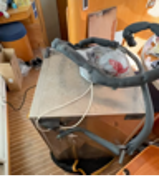
Replacing our old A/C was a mess. The refrigerator had to be disconnected and removed, the cabinet interior disassembled, a divider wall removed, and flooring replaced. This is not a project that we want to do twice!
Here are our general recommendations for a running a 16k BTU marine A/C on battery power:
- Choose an A/C that has reasonable power draw and reasonable start up amperage (or the addition of a soft start component). See full comparison table further down.
- Ensure sufficient battery power of at least 600 Ah LFP or more. I recommend at least 800 Ah or more (double this if using lead-acid batteries instead of lithium iron phosphate).
- Adequate solar charging is crucial. I recommend 2000 watts or more. We originally had only 750 watts when we first installed the A/C, but if you want to actually get anything out of it without running the generator or high powered alternators, you’ll need much more.
- A 5000-watt inverter is optimal, though 3000 watts can be manageable. On our current 3000-watt inverter, we need to pick and choose what we want to run. With normal power use (phones/laptops charging, etc) and the AC running, we will overload our 3000 watt if the water heater kicks on.
For details on our full power setup, including batteries and charging sources, please refer to our article: Connie’s Lithium Powered Electrical System to WFB (Work from Boat)
INVESTIGATING MARINE AIR CONDITIONERS
We considered various models before landing on our current setup. For running an air conditioner on battery power, we need to be most concerned with two things: 1) can it actually start up on our inverter; and 2) how quickly will it drain the battery reserves? A majority of A/Cs demand a much higher starting current than running current, although there are many exceptions nowadays. For a more traditional A/C, you’ll need a “soft start” device, which adds cost and complexity to the setup.
Marine Air Conditioners
| Model | BTUs | Price (USD) | Power Consumption (Watts/Amps/Volts)* | Startup Requirement |
|---|---|---|---|---|
| Velair Compact I16vsd | 16,000 | $2,603 | 977.5W - 8.5A @ 115V | N/A |
| Mabru SC12DC | 12,000 | $5,100 | 528W - 44A @ 12V | N/A |
| Dometic TX18 | 18,000 | N/AÍ | 1,256W - 10.9A @ 115V | N/A |
| Webasto FCF Platinum 16000 | 16,000 | $1,889 | 1,288W - 11.2A @ 115V | 5,556W - 57A @ 115V |
| Dometic Marine Air EnviroComfort AC 16000 | 16,000 | $2,689 | 1,208W - 10.5A @ 115V | 7,130W - 62A @ 115V |
| Marinaire MSBA16K2** | 16,000 | $2,183 | 1,242W/10.8A/115V | 2,024W - 17.6A @ 115V |
| *Some values were derived from the Watts = Volts x Amps formula, as not all specs are listed in the documentation. | **Spoiler: We opted for the Marinaire MSBA16K2 | Note that some of the options on the list have a higher starting wattage than our inverter capacity, thus demanding a soft start device. |
The Velair VSD Velair Compact I16vsd
Velair seems to be the most popular variable speed drive. Time for a quick diversion to talk about variable speed air conditioners!
There is a lot of buzz right now on the relatively new to the market variable speed marine A/Cs. Variable speed A/Cs are able run at different speeds to produce different levels of cooling. Most are marketing as being much more efficient than traditional A/Cs.
This marketing is confusing, because, while the A/C runs at lower speeds, and manufacturers will advertise how much more efficient this is, it also runs more often. Instead of running at full speed, it runs at the speed required to maintain temperature. This doesn’t necessarily translate into energy savings.
Households A/Cs have what’s called a SEER Rating, or Seasonal Energy Efficiency Ratio. So we can just use household A/C ratings to compare the the variable speed technology itself to traditional A/Cs.
Many variable speed A/Cs have similar SEER ratings as the comparably priced, higher-end single-speed counterparts. So by this standard, we can see that just being a variable speed A/C does not automatically give us power savings benefits.
Variable speed has other advantages, though, such as being able to maintain a constant temperature and humidity much better, but that wasn’t really a deciding factor for us (although looking back, the more consistent humidity would have been nice). Plus, variable speed means more complexity, which means more difficult or expensive to repair, and a much higher cost to purchase.
I hope to see some real world comparisons coming out as these devices get more popular.
The Mabru SC12DC
The Mabru SC12DC is definitely getting some buzz among cruisers. It is quite efficient, drawing just 528W (44A at 12V). While its 12,000 BTU cooling capacity was below our needs, it stands out: it’s the only heat pump on our list, and it’s running on 12V, thus avoiding inverter capacity issues and inverter losses.
Heat pumps should be considerably more efficient. And that’s definitely the case here. The Mabru uses just over half of the power of the Velair and under half of the MarinAire while producing 3/4 of the BTUs. One issue to note, however, is that adding such a 12V load might lead to needing heftier 12v cables in your setup.
The downside is the price. It’s more than double the other options. And since 12,000 BTU is the highest BTU in this line, we had to rule it out.
However, if maximizing energy usage is top priority, and cost is no object, this will be a very interesting option to consider.
The Dometic TX18
The Dometic TX18 is a newer model to the market from one of the marine juggernauts. This is also a variable speed unit and also has a titanium coil (as does the MarinAire further down). The titanium coil should be more corrosion resistant and last longer.
Operating at 1256W – 10.9A at 115V at full power and 200W at a minimum, it provides an extra 2000 BTU at the same current draw as the MarinAire. And the display and interface look much more mature than the MarinAire, which should be expected from the much larger, more mature company.
It was impossible to find a price on this thing without getting entangled in a sales process with a dealer, which is always a turn off for me. The aforementioned display is sold separately—another annoyance.
The stated power efficiency, the more mature display, and the variable speed capability definitely make this an interesting option. However, I have had bad experiences from manufacturers that push everything off to a dealer.
Your experience and support will only be as good as the dealer you work with, and that has been problematic for us in the past. If you have a trusted dealer that carries the TX18, it’s definitely with a look.
FCF Platinum & Domestic Marine Air EnviroComfort
Our search was made challenging since the best options were not available at West Marine or Defender. Being able to get the unit shipped quickly from a major retailer would be a plus, so let’s look at the options they provide.
In the 16k BTU range, the Webasto FCF Platinum 16000 and the Dometic Marine Air EnviroComfort AC 16000 seem to be the main options offered by the major marine retailers.
These units both come from tried and tested larger organizations, which may be an advantage for replacement parts in far off places. However, other than availability online and parts availability, there’s not much to write home about. These more traditional models have high startup current requirements yet no real advantage on price to the MarinAire or Velair. So they were a pass for us.
The MarinAire MSBA16K2
Finally, we settled on the Marinaire MSBA16K2. Despite being a younger company founded in 2007, Marinaire impressed us with its included standard features like a titanium condenser, a sound shield, included external display, and a remote.
The display and the remote are definitely not as mature as many of the bigger guys, but we don’t have any complaints. Actually, I can’t say much of the remote, since it’s still wrapped in plastic in the cabinet. Our display is centrally located, and we haven’t found ourselves reaching for the remote.
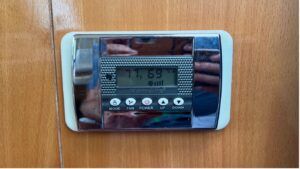
This unit doesn’t have any fancy variable speed compressor nor is it a heat pump, but it has reasonable efficiency and reasonable start up current without a soft start. The unit is nice and quiet with the real audible noise coming from the blower itself. It’s surprising that you can barely hear the compressor itself at all.
The blower is not exactly quiet, but it’s no louder than any others we’ve heard on other boats. In the end, the MSBA16K2 was the best blend of value and performance for our needs.
Actual Runtime on Batteries
Our previous setup with only 750 watts of solar barely met our liveaboard and work-from-boat needs let alone an air conditioner. So upgrading the A/C to over 2000 watts gave us the freedom to turn on the comfort machine fairly often. We often run it on a bright sunny day for 2-3 hours and sometimes again to cool the boat down before bed for a half an hour or so. To truly get that set-it-and-forget-it household-like A/C, we probably need even more solar. I’d estimate that 3,000 watts (1000 watts more) would likely do it.
Considering Additional Cooling for Aft Staterooms
We have two older A/C units in our aft staterooms, which are currently defunct due to their incompatibility with our converted power setup (from 220V 50Hz to 110V 60Hz).
Our plan is to replace these units with the Climma Compact 4.2, although we also considered options from Mabru and Marinaire. Despite the sparse details on the Climma Compact 4.2, we’ve decided to give it a try based on Coastal Climate Control’s reputation.
Coastal Climate Control claims that these small, 4200 btu units, only require 35 amps at 12v including the pump and losses from the inverter. But coming in at $2,737, they’re not exactly cheap! When we complete this upgrade, we’ll update readers with more information.
CONCLUSION
Running a marine A/C off batteries is definitely possible with today’s tech. Given the costs and effort involved, careful planning of the optimal mix of A/C unit efficiency, ample battery and inverter capacity, and effective charging sources is required. I believe it will only get easier as more heat pump options hit the market and the cost of solar power and lithium battery systems continue to come down.
If you’ve got a set up that works great, brag in the comments and everyone reading will benefit. Or, if you’re considering your system options, comment for feedback.

































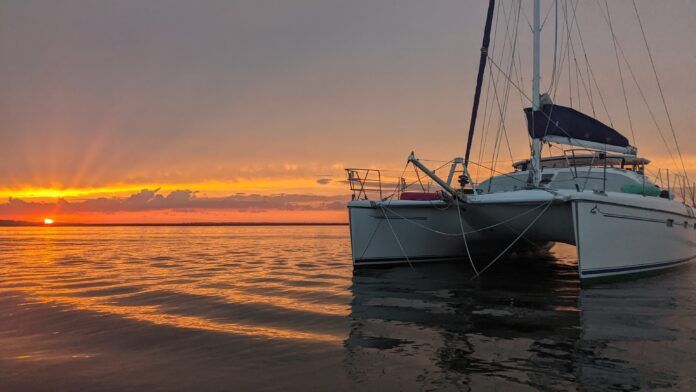
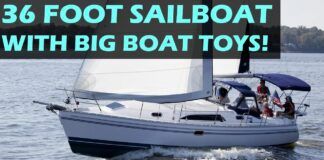



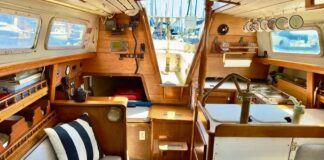
Hey Adam, thanks for the very informatve article…
Namely, it’s spot on to what I’ve been doing since Jan ’23…
I have the Dometic 16k uses about 1200w overnight for a good 6-8hrs A/C nightly…
If cloudy for 5-6 days running my 1.8kW bifacial does not keep up otherwise seems adequate…
I plan to add 2×450/500W bifacial and lower the latitude by 10 degrees in hopes I won’t need more…
My answer to running marine A/C: definitely…!
Fair Winds…
Last fall I finally had enough of my loud, high maintenance panda generator. The difficulty for me to maintain the unit in such cramped spaces and the problem finding a mechanic to do it, were the final straws. Over this past winter I went all in on lithium and 12 V air conditioning. I had the Mabru 12K, 12V unit installed in the main cabin along with 660 A of lithium batteries. This first step was intended to provide air to the main salon and forward cabin. I’m still in the testing phase, and if things work out, I will place a 7K unit in the aft cabin. While I have not seen the combination of summer heat and warm water yet, the results are quite promising. In heat mode the unit operates at a maximum 39 A and reduces below 30 when within 2° of set temperature. Cooling mode seems to be slightly less amp draw. During my only big test so far, I dropped anchor and ran the unit for 19 hours straight in heat mode. Outside air temperature was between 45 and 50° with the unit set at 68°. Water temperature was 45-47 degrees. I started at 100% battery and ended, 19 hours later, at 30% battery. I have 900 W of solar and a 170 amp alternator. With a relatively small battery bank of 660 A it is important to have a large solar array. By the time I left the Anchorage, it only took a couple hours for the solar and alternator to power me up to 100% again. Needless to say, I am quite pleased. We shall see how things go in the heat of the summer, but so far I am happy as a clam to be finished with that damned generator. This is not an inexpensive upgrade. So far I’m at 25k. I figure it would probably cost 20k to have a quiet, high-quality northern lights installed. Maybe more. So I’m not too far off the mark and quite pleased with the results so far. Mark Robinson Catalina-Morgan 440, Journey2
Good myth busting.
I did something similar with my PDQ 32 cat (Dometic Turbo 12,000 BTU) and wrote it up some years ago. Soft start, but not variable speed; as you pointed out, it’s a zero sum game. Interestingly, it is mostly cats that do this. I’m guessing it is related to the convenience of mounting a lot of solar on the hard top.
You really only need AC at night IME. During the day, if you can’t hack the heat, with a breeze, you aren’t going to enjoy sailing anyway. I would typically get underway early, with the family still asleep, and they appreciated being able to stay cool until we were out in the breeze. Chesapeake coves can get down right steamy at night.